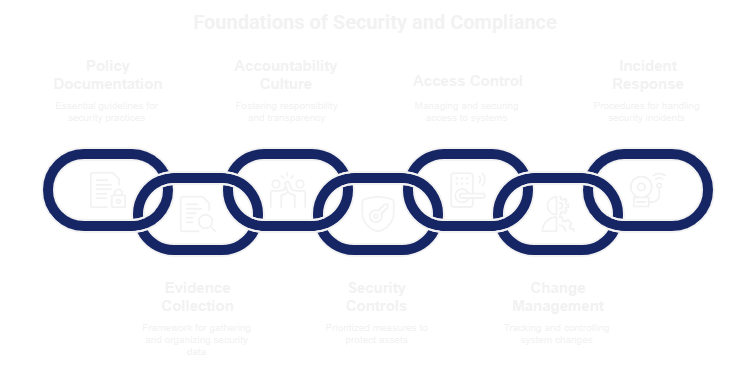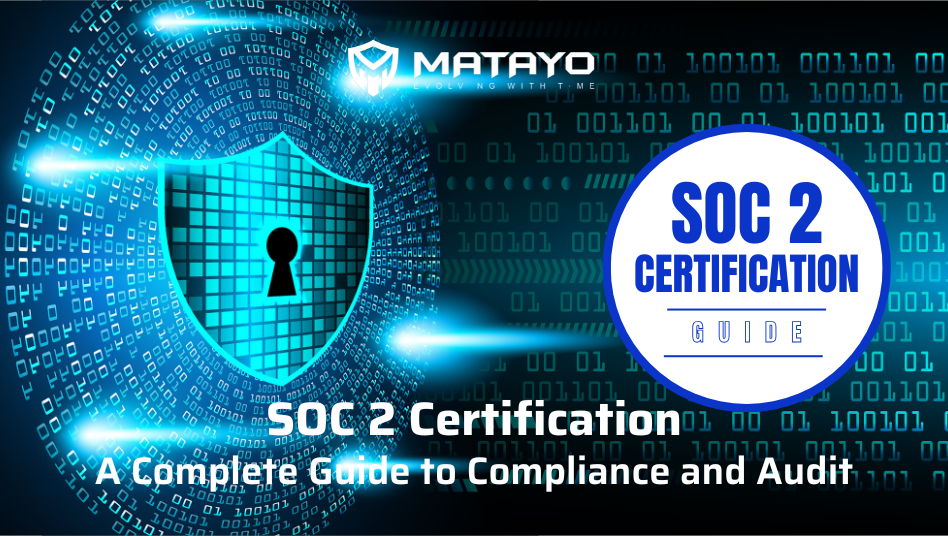SOC 2 certification has become a requirement for cloud-native companies as sensitive customer data is increasingly being managed by such companies. Having a transparent SOC 2 compliance strategy set up helps minimize risks, satisfy client expectations, and often cuts into the audit’s timeline. This article discusses how to consolidate policies and controls, especially in a complex cloud environment, so you can prepare for a successful SOC 2 audit and build trust over the long term.
What is SOC 2 Compliance and Why Does it Matter?
But before we go into how to build a compliance strategy, let’s start with just what it means to be SOC 2 compliant in the first place and why today’s modern, digital-first, cloud-native companies need to care about it.
What Is SOC 2 and Trust Services Criteria?
The SOC 2 standard was created by the AICPA to assess if a company is equipped to protect consumer information. It relies on five Trust Services Criteria: Security, Availability, Processing Integrity, Confidentiality, and Privacy. These are the principles defining how we architect our internal infrastructure, how data is ingested, and how we control data. Auditors test a company’s controls as part of a SOC 2 compliance audit against these criteria. Companies can opt for a Type I (design only) or Type II (design + operational effectiveness) SOC 2 audit. Understanding these requirements is the first step in creating a secure, scalable, and audit-ready environment.

Who Requires SOC 2 and Why It’s Important for Cloud-Native Businesses?
It is especially critical for SaaS, fintech, health tech, and AI-based startups because such startups play in dynamic, cloud-native ecosystems where the infrastructure itself is in a state of flux. Such companies manage sensitive data in distributed systems and often do not have centralized control. Potential customers require service providers to possess a valid SOC 2 certification as a demonstration of security maturity, especially business enterprises. Without it, transactions can be delayed or never occur. SOC 2 not only establishes trust but also gets internal teams on the same page with best practices. It’s a roadmap for managing the intricacies of the cloud, for how to tackle your particular risk, control what you can control, and create enduring resilience.
Laying the Foundation for SOC 2 Compliance: Key Pillars for Strategy

Getting SOC 2 ready is really about building consistency, clarity, and control across groups. And these are the strategies you must prioritize to more effectively line up people, tools, and processes, especially in high-speed, cloud-native spaces.
1.Centralizing Policy Management Across Teams
Disjointed policy ownership is one of the most common barriers to SOC 2 compliance. Security, DevOps, and IT team members often operate within silos, leading to inconsistent documentation and absence of accountability. For SOC 2 compliance, the policy development and enforcement across the firm will also have to be centralized.
Start by implementing a common policy management platform that provides version control, role-based access, and automated reminders. Decide on policy ownership, such as individual policies like access control or data retention, or vendor management with known ownership, and document the process for sending updates and approvals. A standard process not only ensures collaboration goes more smoothly but also gets you better prepared for an SOC 2 audit since they assess governance and documentation practices across functions.
2. Mapping Controls to Cloud Workflows
As more applications become cloud native, the perimeter control model is insufficient. In order to achieve SOC 2 compliance, you’ll have to map your best security controls into your operational workflow directly, from spinning up infrastructure and deploying code through monitoring systems.
For instance, bake IAM policies into Infrastructure-as-Code templates and use tools like AWS Config or Azure Policy to enforce configuration standards democratically. Document formal change management processes, incident response processes, access provisioning processes, etc., and have them mapped to the Trust Services Criteria.
Putting controls into the development pipeline enables teams to stay on pace while also satisfying SOC 2 compliance audit requirements. Having controls in line this way also keeps them from drifting out of control and ensures that audit-ready evidence is being created consistently.
3. Staying Compliant at All Times with Automation
Manual compliance tasks outstrip the capacity to keep up in high-growth companies. Automation is essential to achieve and maintain SOC 2 compliance. Automation is essential to achieve and maintain SOC 2 compliance over the long term.
It is important to automate the collection of evidence, access logging, alerting, and monitoring controls. Or use integrations with solutions like AWS CloudTrail, Datadog, or Lacework to monitor user activity, continuously detect anomalies, and safely manage logs. Automated workflows can also send reminders to team members to meet deadlines, rotate credentials, or refresh security policies.
This not only removes the possibility of human error from the picture, but it also has your source systems primed for audit. Most SOC compliance solutions have dashboards for viewing real-time statuses of controls, so you’re able to go about preparing for your initial SOC 2 audit without panicking at the last moment.
Technical and Organizational Readiness
At the very start of your SOC 2 compliance initiative, you require technical and organizational alignment. Starting from the identification of your cloud assets until access governance and risk analysis, this phase guarantees that you possess a ready-to-audit environment and a successful SOC 2 certification.

1.Creating an Asset Inventory
An accurate asset inventory is the cornerstone of a solid SOC 2 compliance requirement. In cloud-native environments, assets can include everything from cloud accounts, servers, and containers to databases and SaaS applications. Use discovery automation to find and classify all of your assets, on-premises and off.
Categorize your assets by ownership, sensitivity, and use to make access control and monitoring easier. Maintaining a complete inventory isn’t simply a matter of good practice; it’s also required to qualify for a SOC 2 audit, where the auditors will want to see everything that has contact with customer data.
2. Access Control Policy and IAM Governance
Strong access controls are a key element of SOC 2 certification. Your methodology should comply with the principle of least privilege and make use of central IAM systems. Use Okta, Azure AD, AWS IAM, and others to assign user roles, control access to cloud infrastructure, and auto-enable MFA for all. Access needs to be role-based, and everything should be business requirement-related, with users’ privileges audited regularly. Prepare your access review process documentation well, as it’s closely reviewed by the auditors during the SOC 2 compliance audit, and the quality of your IAM controls often makes the difference between passing and failing.
3. Risk Assessment and Gap Analysis
Before working on SOC 2 compliance, perform a comprehensive risk assessment to identify gaps between your systems and SOC 2 compliance standards. Start by identifying where data flows, where third parties are integrated, and where the operational risks might be. Use this to perform a gap analysis of the Trust Services Criteria. Emphasize the missing policies, loose controls, or ghost processes. It’s an excellent method for prioritizing remediation and not having any end-of-cycle surprises during the SOC 2 audit. Several cloud-native organizations use platforms like Tugboat Logic or Audit Board to automate this task. A structured evaluation gives a crystal-clear map and is proof to auditors that your risk strategy is advanced and proactive.
Documentation, Evidence, and Audit Trail Setup
Good documentation and a proper audit trail are essential if you wish to pass any SOC 2 compliance audit. In the cloud age, being in the age of native is all about agility and automation, and that implies that your policy documents, control evidence, and operational logs need to be nice and tidy, easily accessible, and audit-friendly at short notice.

1. Policy Documentation Essentials
Both of these standards call for some formalism, some documentation for the security and internal operational policies. These are access control, incident response, risk management, and vendor assessment. Good documentation not only facilitates SOC 2 compliance but also provides your teams with clean processes to work from. Use tools such as Confluence or Vanta to centralize policy updates and keep them in order. Your SOC 2 auditor will look at these documents during an audit to make sure you’ve implemented the right controls and that you’re following them.
2. Building the Evidence Collection Framework
Evidence is proof that your policies and controls are effective. To achieve SOC 2, companies have to gather and preserve logs, reports, and screenshots for security events and operational controls. Having this process automated with tools such as Drata or Secureframe assists in the accuracy of the responses and saves time in the end. This continuous compilation of evidence is imperative in obtaining and sustaining SOC 2 certification, particularly within the hyperscale cloud environment where systems are in constant scaling and flux.
3. Establishing a Culture of Documentation and Accountability
SOC 2 compliance also necessitates a team effort and team-wide responsibility and accountability. Influence IT operators, security leaders, and engineers to document decisions, access control modifications, and control reviews in their process streams. Use Jira, GitHub templates, or Slack reminders to trigger these habits on a regular basis. This end-to-end culture of documentation fills these gaps, facilitates transparency, and puts you in a position where you’re always ready for a SOC 2 compliance audit without the hassle of having to scramble to collect evidence at the eleventh hour, searching for missing files, etc.
4. Security Controls Every Company Should Prioritize
Security Controls are the building blocks of SOC 2 compliance. Implementing the appropriate controls initially not only secures your systems but also sets the stage for your initial SOC 2 audit and long-term SOC 2 certification.
5. Access Control and Logical Security
Role-based access and MFA must be implemented on all of your systems. Grant access with IAM tools to allow you to manage permissions and audit access. They’re fundamental controls for SOC 2 compliance certification and demonstrate that you have good logical security methodologies in place, something that a SOC 2 audit requires.
6. Change Management and Deployment Tracking
Control infrastructure and application changes through version control and approval workflows. Perform peer reviews of production deploys. These habits are the most important for SOC 2 compliance because they show how your staff handles system changes. Properly documented change logs are a great item of proof in favor of any SOC 2 compliance audit.
7. Incident Response and Detection
Create an incident response plan clearly defining varying levels of severity, the owners’ roles, and communication methods. Monitor using tools to find live attacks. A documented and tested response process is essential to SOC 2 certification and will prove to auditors that your staff is ready to respond to security incidents properly during a SOC 2 audit.
Working with Auditors and Choosing the Right Partner
Selecting the proper compliance partner will either make or break your SOC 2 audit experience. That’s where Matayo is different. With deep experience in cloud-native, they will assist you in centralizing controls, consolidating documentation, and automating evidence collection, speeding your path to SOC 2 certification. Their platform is built for teams today with real-time monitoring of controls and audit-readiness dashboards. Matayo walks you through the SOC 2 compliance journey from gap analysis to auditor coordination. For scale-ups and startups, it translates to less labor, reduced risk, and peace of mind when dealing with your first audit.

Conclusion
SOC 2 compliance is an investment in long-term security, trust, and operational maturity. You can lay the ground for success with well-defined policies and automated controls, and with constant monitoring against those policies. With a partner as brilliant as Matayo, your initial SOC 2 audit is quicker, smoother, and growth-capable.
FAQs
Auditors review controls at the five Trust Services Criteria: Security, Availability, Processing Integrity, Confidentiality, and Privacy.
A SOC 2 audit can only be done by an independent CPA or an AICPA-licensed firm.
The SOC 2 Type 2 report includes 6–12 months of operations to test control effectiveness throughout the period of time.
Yes, both cover similar areas such as risk, access control, and incident response, and so it is pragmatic to coordinate the two practices.
Failures can be corrected and retested mid-period; you’re not stuck for a full year.
SOC 2 Type 2 compliance is a continuous journey. The report is current for 12 months after the monitoring period ends, so the companies need to have annual audits in order to keep their reports current and to show that they remain effective during that period of time.
To truly understand what SOC 2 Type 1 is, it’s best to begin by considering the overarching structure into which it falls, the SOC reporting system released by the American Institute of Certified Public Accountants (AICPA). The framework was created in an effort to help service organizations demonstrate that they secure customer information and process it correctly.

